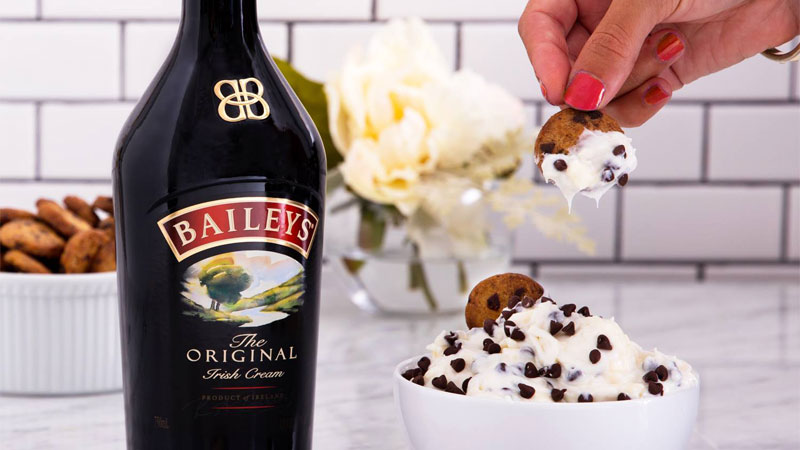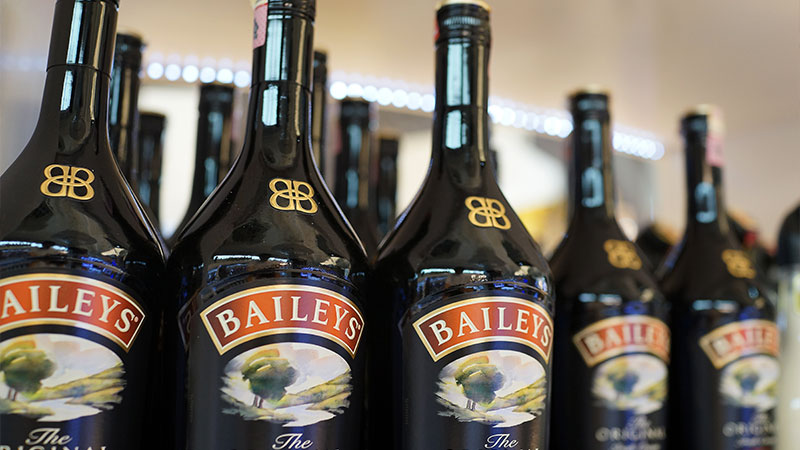It takes the average reader around 12 seconds to cover 50 words of written text. Should you consume these words at a regular pace, therefore, by the time you reach the end of this paragraph, 480 glasses of Baileys Irish Cream will have been consumed worldwide from the moment you started reading.
A simple means of highlighting the immense popularity of the Irish liqueur, this statistic is, of course, just an estimation based on sales data. Other numbers offer more tangible evidence of Baileys’ staggering success, and its outlier status as a brand.
Launched in 1974, Baileys reached the 1-billion-bottles-sold mark in December 2007 and took just 12 more years to notch up a second billion in sales. Now available in 160 countries worldwide, Baileys requires more than 200 million liters of fresh Irish milk annually to produce enough cream to keep up with sales. Each bottle remains shelf stable for two years after production — opened or unopened, refrigerated or otherwise. Most remarkable of all: An early prototype of the product’s recipe took its inventors just 45 minutes to craft — or 108,000 glasses drunk, to use modern-day measurements.
Don’t miss a drop!
Get the latest in beer, wine, and cocktail culture sent straight to your inbox.
Instantly recognizable and deeply beloved, this is how Baileys became an unlikely 2-billion-bottle behemoth.

The Baileys Brief
In the early 1970s, Gilbeys of Ireland sought to capitalize on a tax break being offered by the Irish government. A subsidiary of the wine and spirits distribution company International Distillers & Vintners (I.D.V.), which would eventually become part of Diageo, Gilbeys’ Irish arm had been promised a lengthy tax exemption on any new export product it could bring to market. Keen to capitalize on the opportunity, the company needed something new to sell.
Across the Irish Sea in London, Tom Jago led product development at I.D.V.’s headquarters. For this loosest of briefs — creating a new Irish alcoholic beverage that didn’t rely too heavily on whiskey, because I.D.V. didn’t have strong relationships with distilleries in the country — he hired the consultants David Gluckman and Hugh Seymour-Davies.
Neither of the advertising copywriters had a background in alcohol. Seymour-Davies brought an immense knowledge of Shakespeare, Latin, and classical music to the table, while Gluckman had worked on the successful branding of Kerrygold butter in the early 1960s. Nothing about the duo suggested they were about to devise a multi-billion-bottle booze brand.
“We were, I suppose, unlikely business partners,” Gluckman wrote in a 2017 Irish Times article recounting the history of Baileys.
When Gluckman questioned whether they could lean into his experience with Kerrygold for the “Irish brief,” Seymour-Davies suggested they mix whiskey with cream. With no other ideas even close to viable, they leapt into action, procuring a bottle of Jameson Irish Whiskey and a tub of single cream from a nearby supermarket to their Soho office, in the center of London.
The duo mixed the unlikely pair of ingredients in their office’s kitchen. “[I]t was certainly intriguing, but in reality bloody awful,” noted Gluckman. “Undaunted, we threw in some sugar and it got better, but it still missed something.”
Heading back to the store, they scoured the shelves for a further ingredient that would propel the formula from inoffensive to delicious. A tub of Cadbury’s powdered drinking chocolate proved the final piece of the puzzle, not only making the drink taste “really good,” but also having the effect of making it seem boozier, as if it were a full-strength spirit.
“The whole process had taken about 45 minutes, from the moment Hugh looked at me to the moment we poured our mixture into a cleaned-out screw-top Schweppes’ tonic bottle and I called Tom Jago,” Gluckman wrote.
Though Jago was immediately sold on the concoction, he and Gluckman decided the product should be developed in its entirety before pitching it to the Irish arm of Gilbeys, given the drink’s left-field nature.
Inspiration for a suitably Anglo-Irish name came from Baileys Bistro, a restaurant located near Gluckman and Seymour-Davies’ office. To replace the tonic bottle without spending thousands of pounds developing a new design, Jago suggested the bottle used for the Irish whiskey brand Redbreast, which the company distributed at the time.
And to design the product label, Gluckman enlisted the help of graphic designer, and husband of his secretary, Bob Wagner. His brief once again dialed into his Kerrygold experience, asking for a scene replete with happy cows grazing luscious pastures.
Of the 20 designs submitted, one immediately stuck out. “It was pretty close to the Baileys label that you see today, give or take several tweaks and many millions of pounds over the last 40 years,” wrote Gluckman.
Chemists at I.D.V. ‘s research facility in outer London were hard at work developing a commercially viable version of the recipe. In the meantime, Gluckman and Jago decided to run focus groups so they’d have concrete evidence of consumer interest when the time came to pitch the product in Dublin. The feedback they received far from matched their enthusiasm.
In a male-only group, one domineering individual declared it a “girly drink,” which Gluckman believed discouraged fellow participants from sharing their views, lest they come across as “girly,” too (this was early-’70s Britain, we should remember). Things hardly went better in the women’s focus group, where one member likened its taste to a common diarrhea medicine.
Undeterred, the duo headed to Dublin on a cold, dark, and wet mid-November morning in 1973. The response of Gilbeys Irish team was — thankfully — considerably more positive than that of the focus groups. Attendees were impressed by the bottles and even more struck by the now “finessed” liquid inside. “Much to my relief they didn’t even ask if we had done any market research,” Gluckman wrote. “It wasn’t an issue in those days.”
With Gilbeys of Ireland on board, the time came for consultant Gluckman to say goodbye to his child. He and Seymour-Davies received around £3,000 (almost $4,000) for the product’s development and they were afforded little input in its subsequent launch or development. Recountings of their contribution would become more diluted with each passing year.
“We presented the Baileys idea in 1973, it was launched in 1974, but it was another three years before it began to look like a winner,” Gluckman wrote. “It was almost long enough for people to forget whose idea it was. I remember attending a few consultants’ presentations where the protagonists claimed to have invented Baileys. I managed to keep my cool.”
Irish Cream Innovations
By 1984, Baileys’ sales had grown to almost 50 million bottles annually, though little changed with the brand and liquid during the first quarter-century of its existence. Baileys instead profited from becoming synonymous with holiday-season drinking. And as the male focus group member (tactlessly) predicted, the brand’s audience skewed heavily female, and also older.
With the new millennium came a wave of innovations and extensions, aimed at introducing new drinkers to the brand and bringing Baileys to new occasions. Some have proven to be more successful than others along that way.
Tapping into Britain’s “alcopop” craze of the early 2000s (a kind of sweet hard soda and precursor to hard seltzer), the brand launched Baileys Glide in 2003. Arriving in 200-milliliter bottles at 4 percent ABV, the special-occasion RTD survived less than three years on shelves before it was pulled amid plummeting sales.
Debuted at a similar time, Baileys Minis remain on the market to this day. That the 100-milliliter “oh-so-convenient” bottles are filled with the tried-and-tested original liquid has surely played a part in that. That they offer the perfect stocking filler has no doubt also helped their cause, given Baileys’ strong ties to the holiday season. Google Trend data for the search term “Baileys Irish Cream” shows significant annual spikes every December. And, “40 percent of our sales still happen in the holiday time period,” says Stacey Cunningham, brand director of Baileys and liqueurs for Diageo North America.
While the brand’s first attempt at a new liquid failed to soar, Baileys has since found a winning formula with limited-edition flavored releases. Tapping into longstanding ties between Baileys and food, the launch of Mint Chocolate and Crème Caramel variants offered the first proofs of concept in 2005.
The brand takes a careful approach when adding new flavors, Cunningham says. Most recently, the focus has been on offering products for new occasions.
“We’ve launched things like Apple Pie, to get us into the fall season, and Colada, which gets us into the summer season,” Cunningham says. Baileys this year also introduced Deliciously Light. A permanent addition to the brand’s portfolio, the product arrives with 40 percent less sugar and 40 percent fewer calories than Baileys Original. (Original Irish Cream continues to comprise 85 percent of Baileys’ sales volume.)
In stark contrast to the initial development of Baileys, innovations can these days drag on for years. If their flavors are straightforward, seasonal releases can take 12 to 18 months to launch, explains Funso Faweya, brand manager of Baileys Innovation. On the other hand, more permanent concepts, like Deliciously Light, can take three years or more to develop. “It depends on the complexity of the liquid, the complexity of design, and getting consumer input,” Faweya says.
Modern-day R&D goes well beyond the focus groups of yore. For flavor inspiration, the brand taps into internally produced research reports on the latest trends from Pinterest and Google. A team of influencers, known as the “Treat Collective,” also helps Baileys stay abreast of the latest happenings on social media, Cunningham says.
Beyond identifying the hottest new flavors, the group of “bakers” and “shakers” (read: food and cocktail influencers) creates content for Baileys, allowing them to tap into the latest social media trends at lightning speed.
Scroll through Baileys’ Instagram page and you may be struck by conflicting emotions.
The myriad food and Irish Cream pairings appear delicious and decadent — no-brainers for fans of sweet, boozy treats. And yet, skeptics might find lower-cal Baileys and the slew of limited-edition flavors to be a stretch — calculated plays to remain relevant, which could risk tainting a nearly 50-year-old iconic booze brand.
By most accounts, Baileys’ strategy appears to be paying off. The trio of Apple Pie, Deliciously Light, and Colada releases helped drive a 31 percent net sales volume increase between July 2020 and June 2021, according to a company representative. Meanwhile, the overall Baileys family apparently accounts for 50 percent of Irish spirits exports. (Baileys representatives declined VinePair requests for more accurate volume and value sales figures.)
As unassuming as the black bottles of Original Baileys appear, the brand’s tale continues to surprise. Concocted by a couple of copywriters, the liquid has spawned an army of imitators, though for all intents and purposes, Irish cream liqueur remains a one-brand category. At a time when consumers reportedly care more about calories and carbs than treating occasions, Baileys is posting double-digit volume growth.
Then again, Baileys has always succeeded against the odds.
In the mid-1970s, a bottle of Baileys was presented to Abe Rosenberg, a New York-based liquor exec who had famously transformed J&B Rare into the best-selling Scotch in America the previous decade. Rosenberg is said to have mocked the label and sipped on the liquid with nary an ounce of enthusiasm, reportedly claiming, “That sh*t will never sell!”
Nearly a half century on, 2 billion bottles say otherwise.



